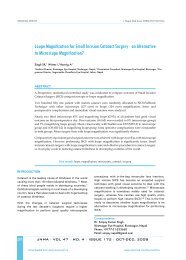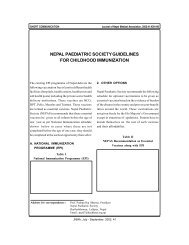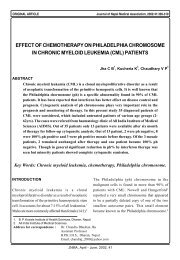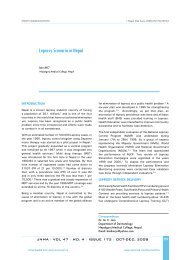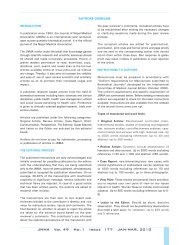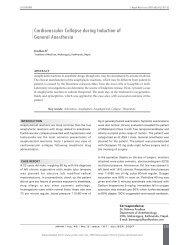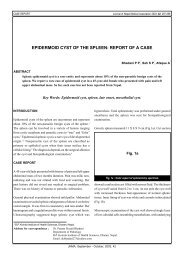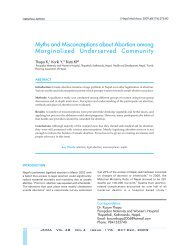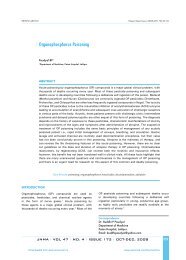Full Text PDF - Journal of Nepal Medical Association
Full Text PDF - Journal of Nepal Medical Association
Full Text PDF - Journal of Nepal Medical Association
You also want an ePaper? Increase the reach of your titles
YUMPU automatically turns print PDFs into web optimized ePapers that Google loves.
CASE REPORT <strong>Journal</strong> <strong>of</strong> <strong>Nepal</strong> <strong>Medical</strong> <strong>Association</strong>, 2001:40:212-214<br />
PLACENTA PREVIA ACCRETA<br />
Giri A 1 , Gurung G 1<br />
Pradhan N 1 , Manandhar B 1 , Rana A 1<br />
ABSTRACT<br />
Placenta accreta is defined as any placental implantation in which the placenta is<br />
abnormally and firmly adherent to the underlying uterine wall in part or in total. The<br />
probable cause is defective decidual formation as shown by its occurence in area where<br />
the endometrium is deficient or damaged.<br />
The commonest condition associated with it are placenta previa and previous caesarean<br />
section. A case <strong>of</strong> placenta previa accreta is described herewith in a 2nd gravida who<br />
eventually needed emergency caesarean hysterectomy (total) due to pr<strong>of</strong>use bleeding.<br />
Key Words: Placenta accreta, placenta, caesarean hysterectomy.<br />
INTRODUCTION<br />
Placenta accreta is defined as the condition where<br />
placenta is firmly adherent to the underlying<br />
uterine wall in part or in total. The commonest<br />
condition associated with it are placenta previa and<br />
previous caeserean section. It is said that with<br />
placenta previa, the incidence approaches 10% but<br />
in the presence <strong>of</strong> previous caeserean section and<br />
placenta previa, the incidence goes up to 25%.<br />
Placenta accreta is one <strong>of</strong> the most dreaded<br />
complication <strong>of</strong> pregnancy with significant<br />
maternal morbidity and mortality due to severe<br />
haemorrhage, uterine perforation and infection.<br />
The incidence varies from 1:2500 to 1:7000<br />
deliveries in recent years. According to clark et<br />
al., 1 25%, <strong>of</strong> patient with placenta previa and one<br />
previous C.S. and at least 50% <strong>of</strong> patients with<br />
two or more C. Section developed placenta accreta<br />
1. Dept. <strong>of</strong> Obstetrics & Gynaecology, Tribhuvan University Teaching Hospital, Institute <strong>of</strong> Medicine, Maharajgunj.<br />
Address for correspondence : Dr. A. Giri, Dept. <strong>of</strong> Obstetrics & Gynaecology<br />
Tribhuvan University Teaching Hospital<br />
Institute <strong>of</strong> Medicine, Maharajgunj, <strong>Nepal</strong>.<br />
JNMA, October - December, 2001, 40
Giri et. al. : Placenta Previa Accreta 213<br />
and 82% required caeserean hysterectomy. For this<br />
reason, one must be very careful while managing<br />
cases complicated by placenta previa in previous<br />
C. Section right from making the diagnosis so as<br />
to make best possible pre-op. arrangement.<br />
CASE REPORT<br />
A 29 years old second gravida with one live baby<br />
who was delivered by caesarean section for CPD<br />
was admitted at 26+6 weeks pregnancy with<br />
pr<strong>of</strong>use vaginal bleeding for 4 hours. The bleeding<br />
was fresh and painless. Her previous USG done at<br />
23 wks. showed normal placental localisation.<br />
There were 2 other episodes <strong>of</strong> bleeding at 28 and<br />
32 wks while she was on rest but fetal condition<br />
was satisfactory.<br />
At 36 completed week, elective CS was done under<br />
G.A. As placenta was implanted in lower segment<br />
(Fig. 1), baby was delivered cutting through the<br />
placenta. At the attempt to remove the placenta<br />
manually, it was found to be densely adherent to<br />
the lower uterine segment in the previous caesarean<br />
scar. It was very difficult to separate the placenta.<br />
In view <strong>of</strong> pr<strong>of</strong>use bleeding that occured at the<br />
attempt to separate the placenta emergency<br />
caesarean (total) hysterectomy (Fig. 2) was<br />
At admission, she was quite pale, tachycardic with<br />
pulse rate <strong>of</strong> 120/min, weak volume and BP <strong>of</strong> 80/<br />
40 mmHg.<br />
Her abdomen was non tender and the height <strong>of</strong><br />
uterus was corresponding to the period <strong>of</strong> gestation.<br />
The FHR was 160/min and regular. She was<br />
immediately resuscitated with fluids and blood was<br />
transfused. When her general condition improved<br />
urgent USG was done which showed complete<br />
placenta previa (Fig. 1) with viable fetus<br />
corresponding to same gestational age.<br />
Fig. 2<br />
Fig. 2, Hysterectomy specimen.<br />
Placental membrane is shown to be adherent.<br />
Fig. 1<br />
Fig. 1, Placenta Previa Accreta seen in<br />
USG is posterior Placentation.<br />
proceeded with the diagnosis <strong>of</strong> placenta accreta<br />
in mind.<br />
Intraoperatively patient went into shock due to<br />
massive bleeding (3-3.5 litres) for which she was<br />
transfused 6 units <strong>of</strong> blood. In immediate post<br />
operative period her condition did not improve and<br />
she went into respiratory arrest. She was intubated<br />
immediately and Inj. adrenaline 0.1mg was given<br />
to raise her BP which was unrecordable at that time.<br />
JNMA, October - December, 2001, 40
214 Giri et. al. : Placenta Previa Accreta<br />
She was shifted to ICU where she was kept on<br />
oxygen, inotropic support with dopamine,<br />
antibiotics (cephazoline 500mg 6 hrly &<br />
metronidazole 500mg 8hrly) and fresh blood was<br />
transfused to compensate for her loss. She was<br />
persistently tachycardic but maintaining the BP <strong>of</strong><br />
100-110 mm Hg systolic. In 2nd post op day, she<br />
developed abdominal distension and USG done<br />
showed intraabdominal collection which was self<br />
aspirated through the drain site. About 800ml <strong>of</strong><br />
old blood was removed. From 3rd post op day, her<br />
condition started improving and both mother and<br />
baby were discharged 14 days after surgery in better<br />
condition.<br />
DISCUSSION<br />
Planned elective cesarean hysterectomy has better<br />
outcome than emergency procedure in terms <strong>of</strong><br />
morbidity (more blood loss, prolonged operative<br />
time, high infection rate) and mortality. 2 In our<br />
case as we could not envision this probable<br />
situation, the patient went in Hemorrhagic shock<br />
intra-operatively. Reprospectively, can we say that<br />
bleeding f rom the placenta could have been<br />
avoided The upper uterine caesarean delivery<br />
could have avoided the bleeding from the cut edges<br />
<strong>of</strong> the placenta that bled torrentially, needing 6 units<br />
blood per-operatively. Planned elective caesarean<br />
hysterectomy with upper uterine segment fetal<br />
delivery could have been better option.<br />
Recent techniques like TVS with color doppler<br />
imaging has been documented to be useful in<br />
detection <strong>of</strong> placenta accreta antenatally. 3 One can<br />
also think <strong>of</strong> angiographic ballon occlusion &<br />
embolization 4 <strong>of</strong> internal iliac arteries, should the<br />
problem arise in a woman desirous <strong>of</strong> preserving<br />
the uterus.<br />
REFERENCES<br />
1. Clark SL, Koonings PP, Phelan JP, Placenta<br />
previa/accreta and prior cesarian section.<br />
Obstet gynecol 1987, 66:89.<br />
2. Zelop cm et al : Emergency peripartum<br />
hysterectomy AM J Obstet gynaecol<br />
168:1443, 1993.<br />
3. Lerner JP, Deane S, Timor-Tritsch LE.<br />
Characterisation <strong>of</strong> placenta accreta using<br />
transvaginal sonography and colour Doppler<br />
imaging. Ultrasound obstet gynaecol 1995,<br />
5:198.<br />
4. Dubois J, Garel L et al. Placenta percreta<br />
ballon occlusion and embolization <strong>of</strong> the<br />
internal iliac arteries to reduce intra-operative<br />
blood loss. AM J obstet gynaecol 1997,<br />
176:723.<br />
!""!""!<br />
JNMA, October - December, 2001, 40



